Spot News Roundup
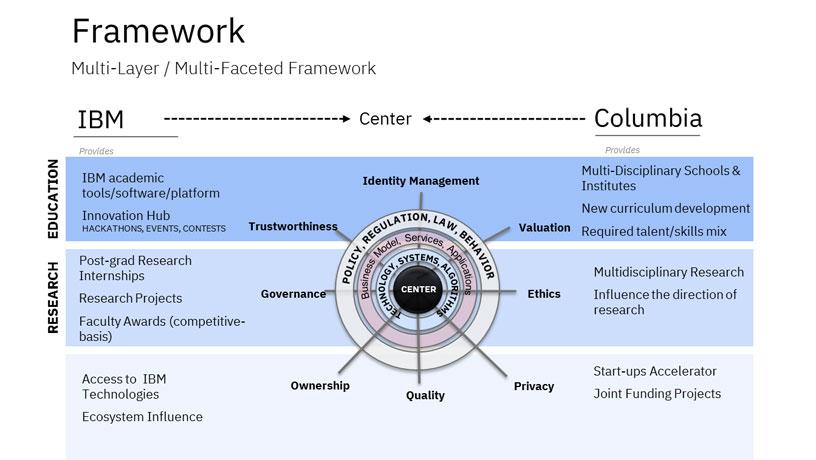
THE FUTURE OF DATA TRANSPARENCY
Marking the latest milestone in a long history of collaboration, Columbia University and IBM have joined forces for the new Columbia-IBM Center for Blockchain and Data Transparency. The collective will advance compelling applications of blockchain and address growing demands for data transparency, as well as establish an innovation accelerator to incubate entrepreneurship.
Blockchain technology represents the next generation of secured, transparent transactions, enabling permissioned parties to access data in real time and opening up new ways to exchange value through the digital representation of assets. Such functionality allows people and organizations to share data in a highly secure, privacy-protected manner and could transform global business by reducing the need for trusted third-party verifications.
Combining Columbia’s strengths in data science, engineering, business, and law with IBM’s extensive expertise in research, development, and helping global clients apply blockchain throughout a wide range of business processes, the center will convene cross-disciplinary teams from academia, industry, and government to explore issues related to the policy, trust, sharing, and consumption of digital data in blockchain and other privacy-preserving technologies.
Primary focus areas include secure multiparty computation, homomorphic encryption, secure hardware, and fraud reduction; and improving precision medicine through insight from many data sources. The center will offer policy and regulatory guidance, foster entrepreneurs, and spur the creation of new business models and services that support sharing data in a secure, privacy-preserving, and tamper-proof manner.
“The new center further solidifies New York City as a hub for technical innovation,” says John H. Coatsworth, Columbia University provost. “Our students and faculty, working together with IBM, will play an important role in the vibrant exchange of ideas and research surrounding this transformative technology.”
A steering committee consisting of Columbia faculty and academic leaders and IBM Research scientists and business leaders will help guide the center. A formal call for proposals for curriculum development, business initiatives, and research programs is scheduled for later this year.
“Our work with clients has shown that blockchain can benefit industries, and with that comes a responsibility to deploy it in ways that will foster greater trust and transparency in data,” said Arvind Krishna, senior vice president of Hybrid Cloud and director of IBM Research. “With Columbia, we are able to bring together leading thinkers on applying blockchain and data best practices based on extensive research and business experience and together prepare a new generation of technologists and business leaders.”
SHEDDING LIGHT ON CANCER TREATMENT
A new optical imaging system developed in Professor Andreas Hielscher’s lab uses red and near-infrared light to identify breast cancer patients who will respond to chemotherapy. The noninvasive method of measuring blood flow dynamics within a single holding of breath may be able to predict response to chemotherapy as early as two weeks after treatment begins.
“There is currently no method that can predict treatment outcome of chemotherapy [this] early on, so this is a major advance,” said Hielscher, professor of biomedical engineering and electrical engineering at Columbia Engineering, professor of radiology at Columbia University Irving Medical Center (CUIMC), and a member of the Breast Cancer Program at the Herbert Irving Comprehensive Cancer Center at NewYork-Presbyterian/CUIMC.
Because chemotherapy drugs also affect the vasculature inside tumors, and because blood absorbs light, Hielscher’s research team suspected they might be able to pick up optical clues of vascular changes. Their dynamic tomographic system generates 3D images of both breasts simultaneously, enabling researchers to examine blood flow, see how vasculature changes, and look at how blood interacts with tumors.
“This helps us distinguish malignant from healthy tissue,” Hielscher said, noting that the system is also potentially cheaper and safer than methods like MRI, X-ray imaging, and ultrasound.
The researchers hope that the system will enable personalized treatment for individual patients. They are currently refining the technology and planning clinical trials with the goal of bringing their system to market over the next three to five years.
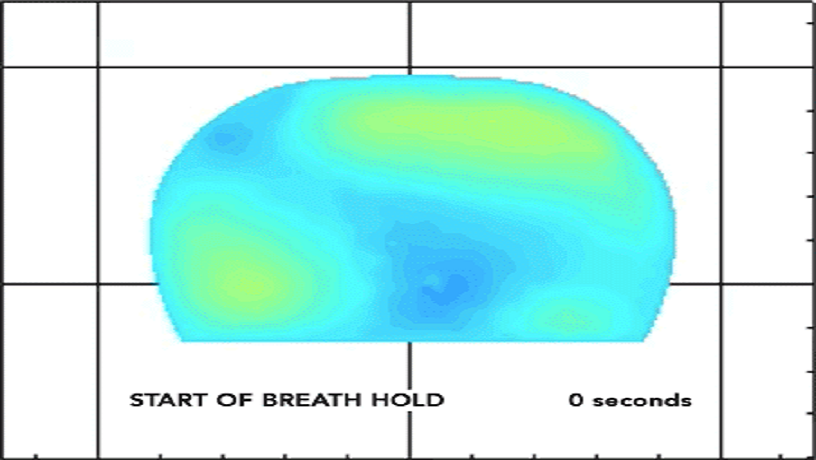
BETTER MOLECULAR FINGERPRINTING
In an achievement with major implications for precision monitoring, Columbia engineers have pioneered dual-frequency combs with two frequency comb generators on a single millimeter-sized, silicon-based chip.
A frequency comb is a special kind of light beam with many different frequencies, or “colors,” precisely spaced. When this light shines through a chemical specimen, certain colors are absorbed by the specimen’s molecules, reliably identifying its composition. Known as frequency-comb spectroscopy, the technique enables molecular fingerprinting and can be used to detect toxic chemicals in industrial areas, to implement occupational safety controls, and to monitor the environment. A dual comb, covering a broader range of frequencies, can vastly accelerate the speed of measurements.
“This is the first time a dual comb has been generated on a single chip using a single laser,” said Michal Lipson, Higgins Professor of Electrical Engineering, who oversaw the research with Alexander Gaeta, Rickey Professor of Applied Physics and of Materials Science.
Conventional dual-comb spectrometers are expensive, bulky tabletop instruments, but the researchers’ chipscale dual comb is portable for real-time sensing and spectroscopy in field environments. Their device is also especially suited for liquids and solids, which have broader absorption features.
Their work has already demonstrated the broadest-ever frequency span of any on-chip dual comb, enabling the same device to detect a wider range of chemicals—the team is now working on broadening that span further and increasing resolution by tuning the lines of the combs.
“There is now a path for trying to integrate the entire device into a phone or a wearable device,” Gaeta said.

A BREAKTHROUGH FOR BLIND GAMERS
Technology developed by Columbia Engineers now offers visually impaired gamers the same speed, control, and excitement that sighted peers enjoy. The RAD—racing auditory display—utilizes an audio-based interface potentially compatible with almost any racing video game.
“Our challenge was to give visually impaired players enough information about the game so that they could have the same sense of control and thrill that sighted players have,” said computer science PhD candidate Brian A. Smith, who worked with Professor Shree Nayar. “But not so much information that they would get overwhelmed by audio overload or bogged down figuring out how to interpret the sounds.”
Games accessible to the blind tended to face a fundamental trade-off between complexity and pace. Many are packed with competing sources of information that players must sift through, inhibiting the fun factor, while others are so simplified that they offer visually impaired gamers little to do but follow orders. By contrast, the RAD provides just enough relevant information to act.
“The RAD is the first system to make it possible for people who are blind to play a ‘real’ 3D racing game—with full 3D graphics, realistic vehicle physics, and complex racetracks,” Smith said. “It’s not a dumbed down version.”
Building on audio navigation and blind-accessible driver assistance systems, the RAD includes a sound slider for understanding cars’ speed and trajectory and a turn indicator system for alerting players about upcoming moves in advance. Players rave that it helps them understand the race and perform in unprecedented fashion.
“We think the RAD marks the beginning of a whole new suite of such tools,” Smith said.
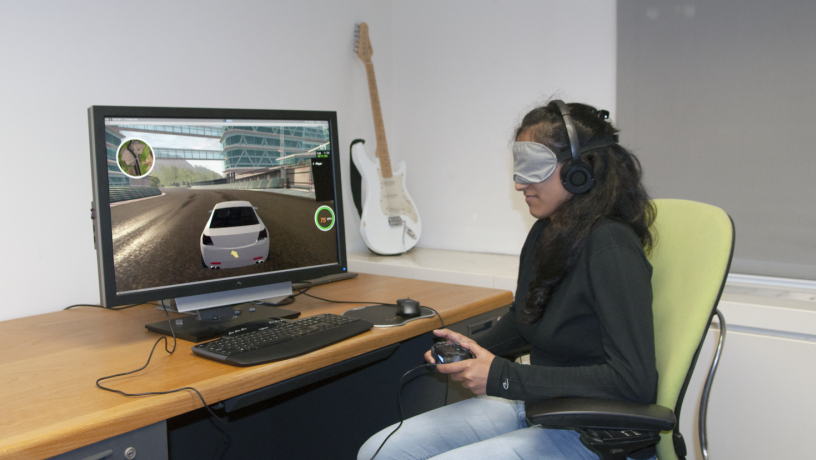
GROWING HEARTS
The ability to generate human cardiac tissue that behaves like native heart muscle, enabling study under fully controlled conditions, would revolutionize drug development—and Columbia researchers are closing in.
A team of investigators has developed a radically new approach to growing adultlike human heart muscle in just four weeks of cultivating human induced pluripotent stem cells (iPSCs) derived from blood. Essentially, they compressed nine months of development into a faster and more complete transition to maturity, forming tissues from early-stage iPSC-derived cardiomyocytes soon after initiation of spontaneous contractions by subjecting cells to escalating physical conditioning.
“It took a lot of creative thinking and clever engineering by the whole team across both campuses of Columbia University to develop the model we now have—a highly matured, patient-specific heart muscle that can be used for studies of heart development, physiology, disease, and responses to drugs,” said Gordana Vunjak-Novakovic, University Professor, Mikati Foundation Professor at Columbia Engineering, and professor of medical sciences at Columbia University Vagelos College of Physicians and Surgeons.
Researchers cultured cardiomyocytes on an advanced “organ on a chip,” applying electrical pacing to gradually induce bioengineered heart muscle to twitch and perform like healthy cardiac tissue. Instead of the gentle mechanical stress in a natural fetal heart, researchers applied a special electromechanical conditioning regime to help tissue develop, achieving rapid and unprecedented maturation of structure, metabolism, and function.
The team has already demonstrated that bioengineered tissues can recapitulate the phenotype of several heart conditions, and they are extending these studies into broader challenges of modeling disease. They anticipate that their research may soon facilitate discovery of new therapeutic targets and treatment modalities.

HIDING INFORMATION IN PLAIN SIGHT
Columbia computer scientists have created a new way to embed hidden information in ordinary text by imperceptibly changing font shapes. Dubbed FontCode, the method encodes information using minute perturbations, such as altering stroke width, and varying the curves in serifs. Though invisible to humans, the signatures are machine-readable as barcodes and can easily be further encrypted.
“While there are obvious applications for espionage, we think FontCode has even more practical uses for companies wanting to prevent document tampering or protect copyrights, and for retailers and artists wanting to embed QR codes and other metadata without altering the look or layout of a document,” said Changxi Zheng, associate professor of computer science, who developed the method with PhD candidate Chang Xiao and Cheng Zhang MS’17.
Earlier techniques have hidden messages in particular files or resized white space to denote a 0 or 1, but FontCode is the first to work with most document types and retain hidden data even when a document or an image with text is printed or converted to another file type. Deciphering is done by convolutional neural networks (CNNs), which can recognize both regular vector-drawn fonts and noisier text that might be distorted or blurry.
Recognition errors are inevitable, and a key challenge was ensuring messages could be consistently recovered. The team turned to the 1,700-year-old Chinese Remainder Theorem, which identifies an unknown number from its remainder after much division, to receive messages even when numerous letters are compromised. So far, they’ve managed to recover messages even with 25 percent of letter perturbations unreadable.
The researchers are now working on extending FontCode to other languages and character sets, including Chinese.
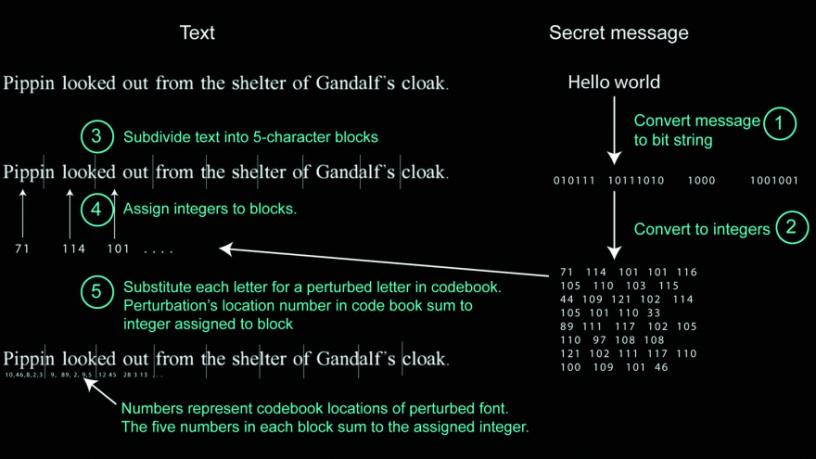
NEW AND IMPROVED SILK
Fabrics made from silkworm fibers have long been treasured for their luster and coolness, but Columbia engineers have found that fibers produced by the caterpillars of the Madagascar comet moth (Argema mittrei) have a few extra superpowers. These cocoon fibers have not only superior cooling properties but also exceptional capabilities for transmitting light signals and images.
Led by Nanfang Yu, associate professor of applied physics, the team characterized the unusual optical properties associated with one-dimensional nanostructures in the cocoon fibers, and developed a technique to spin artificial fibers that mimic and improve upon the originals.
“The comet moth fibers are the best natural fibrous material to block sunlight we’ve ever seen,” said Yu, an expert in nanophotonics. “They can guide light signals or even transport simple images from one end to the other end of the fiber. This means we might be able to use them as a biocompatible and bioresorbable material for optical signal and image transport in biomedical applications.”
A single solid fiber from the comet moth caterpillar reflects more than 70 percent of visible light, far beyond conventional textiles. The remarkable reflectivity extends into the infrared spectrum, and fibers also absorb ultraviolet light, making them ideal for blocking sunlight. With engineered nanostructures, the researchers’ artificial fibers can reflect about 93 percent of sunlight. Yu is currently working on mass-producing such nanostructured fibers, aiming to integrate them into existing industrial production.

CORRECTING VISION, GENTLY
By 2020, some experts posit, about 2.5 billion people will suffer from nearsightedness. While eye glasses and contact lenses are disposable solutions, corneal refractive surgery offers a more permanent remedy—but one that is invasive, subject to complications, and in rare cases can cause permanent loss of vision.
Enter Columbia Engineering researcher Sinisa Vukelic, a lecturer in the discipline of mechanical engineering, who has developed a new, noninvasive approach showing great promise in preclinical models for treating conditions like myopia, hyperopia, and astigmatism. His method uses a femtosecond oscillator, an ultrafast laser that delivers pulses of very low energy, for selective and localized alteration of corneal tissue without causing cellular damage or tissue disruption. The nonsurgical technique, which changes tissues’ macroscopic geometry, is potentially accessible even to patients with thin corneas and other issues that preclude refractive surgery.
“We think our study is the first to use this laser output regimen for noninvasive change of corneal curvature or treatment of other clinical problems,” said Vukelic.
His approach is based on taking advantage of low-density plasma created as a side effect of multiphoto imaging, transforming it into viable means for enhancing mechanical properties of the cornea and other collagenous tissue. Induction of plasma causes ionization of water, producing unstable molecules that interact with collagen fibrils to progressively alter the corneal macrostructure. Because the process is photochemical, it does not disrupt tissue and the induced changes remain stable.
The research team is currently building a clinical prototype, figuring out how to personalize treatment, and planning to start clinical trials by year’s end. “What’s especially exciting is that our technique is not limited to ocular media—it can be used on other collagen-rich tissues,” Vukelic said.

TOWARD TINIER TRANSISTORS
Ever-shrinking transistors are essential for faster and more efficient computer processing. For decades, progress has depended on making transistors simultaneously smaller and more powerful, down to the nanometer (nm) scale. But in recent years the pace hit a plateau, and researchers began wondering if transistors had finally hit their size limit. Not just yet, Columbia engineers have demonstrated.
A key challenge has been “leakage current,” which results when the gap between metal electrodes narrows to the point that electrons are no longer contained, a phenomenon known as quantum mechanical tunneling. Scientific consensus long held that vacuum barriers are the most effective means to mitigate tunneling. A collaboration among researchers across Columbia, Shanghai Normal University, and the University of Copenhagen upended conventional wisdom by synthesizing the first molecule capable of insulating at the nanometer scale better than a vacuum barrier.
Exploiting the wave nature of electrons, the group designed a rigid silicon-based molecule under 1 nm in length that blocks tunneling conduction at the nanoscale, a strategy that’s compatible with current industry standards.
“There’s a lot to be learned in this area that will help shape the future of nanoscale electronics,” said Latha Venkataraman, professor of applied physics, who heads the lab where researcher Haixing Li conducted the project’s experimental work. “Our molecular strategy represents a new design principle for classic devices, with the potential to support continued miniaturization in the near term.”
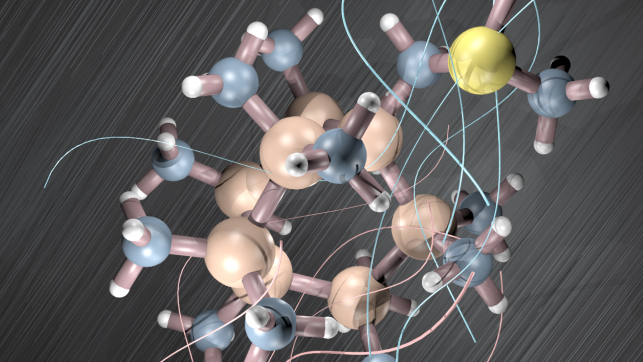
WAVES OF MEMORY
Human cognition depends on coordinated neural activity among networks spread throughout the brain. Scientists long assumed that commonly measured oscillations there were stationary signals occurring independently in different regions. Biomedical engineers at Columbia recently discovered that model is fundamentally flawed: oscillations actually move rhythmically across the brain, reflecting patterns of neuronal activity that propagate across the cortex.
Examining recordings from subjects who had performed memory tests, the team found large brain regions with oscillations linked to cognition at specific frequencies, suggesting that neurons in those areas rhythmically activate to support recall.
“This indicates that traveling waves are significant for memory and cognition,” said Joshua Jacobs, assistant professor of biomedical engineering. “Our findings show that these oscillations are an important mechanism for large-scale coordination in the human brain.”
The researchers studied direct brain recordings from 77 epilepsy patients with electrodes placed for mapping seizures. Two novel methods helped analyze the data: the team measured individual oscillations simultaneously from multiple electrodes, and they developed a new analytical framework for observing the instantaneous movement of each traveling wave. Their findings demonstrate that neuronal oscillations propagate information and play a significant role in supporting brain connectivity.
The investigators are now exploring how the waves impact behaviors like spatial navigation and long-term memory, and developing new methodologies to test other kinds of brain oscillations.
“In addition to opening new directions for fundamental brain research on connectivity and memory, our work suggests that clinicians can measure patterns of traveling waves to characterize an individual’s brain connectivity,” Jacobs said. “Traveling waves are like ocean waves, moving across the surface of the cortex, and may also provide a new type of signal that can be used for brain-computer interfaces.”
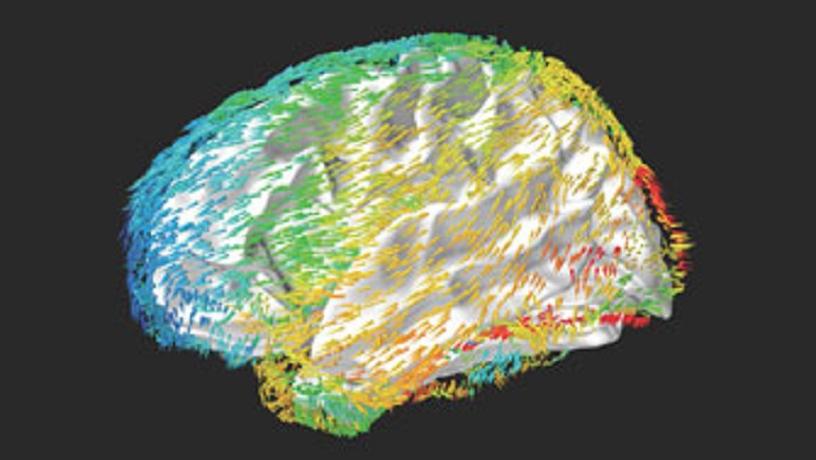
ANTICIPATING CLIMATE CHANGE
Modeling climate over days and weeks, let alone months and years, is an astoundingly difficult task: in predicting times to come, how can scientists accurately represent complex phenomena like clouds—along with their atmospheric heating and moistening?
A group of investigators led by Pierre Gentine, associate professor of earth and environmental engineering, is developing a method for using machine learning to better represent clouds in global and regional climate models.
“Our approach may open up a new possibility for a future of model representation in climate models that are data driven and built ‘top-down,’” said Gentine, who is also a member of the Earth Institute and the Data Science Institute. “That is, by learning the salient features of the processes we are trying to represent.”
The team used idealized models as a proof of concept for their novel approach, training a deep neural network—named Cloud Brain—to learn from simulations explicitly representing clouds. The network skillfully predicts many of the cloud heating, moistening, and radiative features essential for climate simulation.
Because global temperature sensitivity to CO2 is strongly linked to cloud representation, Cloud Brain may also improve forecasts of future weather. The team’s fully coupled climate models are showing immense promise predicting greenhouse gas responses.
“Our study shows that machine learning techniques help us better represent clouds and thus better predict global and regional climate’s response to rising greenhouse gas concentrations,” Gentine said. “This could be a real game changer for climate prediction.”

